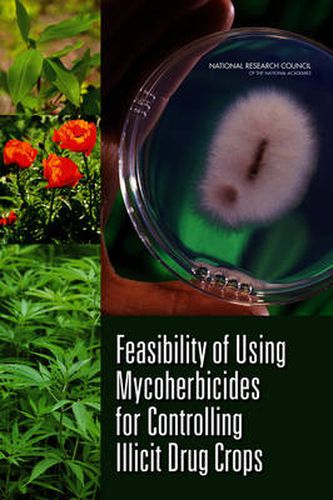Readings Newsletter
Become a Readings Member to make your shopping experience even easier.
Sign in or sign up for free!
You’re not far away from qualifying for FREE standard shipping within Australia
You’ve qualified for FREE standard shipping within Australia
The cart is loading…






The control of illicit-drug trafficking and drug use is a difficult and complex process that involves a variety of prevention, control, treatment, and law enforcement strategies. Eradication strategies for controlling illicit-drug crops are used to target the beginning of the drug-supply chain by preventing or reducing crop yields. Mycoherbicides have been proposed as an eradication tool to supplement the current methods of herbicide spraying, mechanical removal, and manual destruction of illicit-drug crops. Some people regard them as preferable to chemical herbicides for controlling illicit-drug crops because of their purported specificity to only one plant species or a few closely related species. As living microorganisms, they have the potential to provide long-term control if they can persist in the environment and affect later plantings. Research on mycoherbicides against illicit-drug crops has focused on three pathogens: Fusarium oxysporum f.sp. cannabis for cannabis (Cannabis sativa), F. oxysporum f.sp. erythroxyli for coca (Erythroxylum coca and E. novogranatense), and Crivellia papaveracea or Brachycladium papaveris (formerly known as Pleospora papaveracea and Dendryphion penicillatum, respectively) for opium poppy (Papaver somniferum). Feasibility of Using Mycoherbicides for Controlling Illicit Drug Crops addresses issues about the potential use of the proposed mycoherbicides: their effectiveness in eradicating their target plants; the feasibility of their large-scale industrial manufacture and delivery; their potential spread and persistence in the environment; their pathogenicity and toxicity to nontarget organisms, including other plants, fungi, animals, and humans; their potential for mutation and resulting effects on target plants and nontarget organisms; and research and development needs. On the basis of its review, the report concludes that the available data are insufficient to determine the effectiveness of the specific fungi proposed as mycoherbicides to combat illicit-drug crops or to determine their potential effects on nontarget plants, microorganisms, animals, humans, or the environment. However, the committee offers an assessment of what can and cannot be determined at the present time regarding each of the issues raised in the statement of task. –Publisher’s description.
$9.00 standard shipping within Australia
FREE standard shipping within Australia for orders over $100.00
Express & International shipping calculated at checkout
The control of illicit-drug trafficking and drug use is a difficult and complex process that involves a variety of prevention, control, treatment, and law enforcement strategies. Eradication strategies for controlling illicit-drug crops are used to target the beginning of the drug-supply chain by preventing or reducing crop yields. Mycoherbicides have been proposed as an eradication tool to supplement the current methods of herbicide spraying, mechanical removal, and manual destruction of illicit-drug crops. Some people regard them as preferable to chemical herbicides for controlling illicit-drug crops because of their purported specificity to only one plant species or a few closely related species. As living microorganisms, they have the potential to provide long-term control if they can persist in the environment and affect later plantings. Research on mycoherbicides against illicit-drug crops has focused on three pathogens: Fusarium oxysporum f.sp. cannabis for cannabis (Cannabis sativa), F. oxysporum f.sp. erythroxyli for coca (Erythroxylum coca and E. novogranatense), and Crivellia papaveracea or Brachycladium papaveris (formerly known as Pleospora papaveracea and Dendryphion penicillatum, respectively) for opium poppy (Papaver somniferum). Feasibility of Using Mycoherbicides for Controlling Illicit Drug Crops addresses issues about the potential use of the proposed mycoherbicides: their effectiveness in eradicating their target plants; the feasibility of their large-scale industrial manufacture and delivery; their potential spread and persistence in the environment; their pathogenicity and toxicity to nontarget organisms, including other plants, fungi, animals, and humans; their potential for mutation and resulting effects on target plants and nontarget organisms; and research and development needs. On the basis of its review, the report concludes that the available data are insufficient to determine the effectiveness of the specific fungi proposed as mycoherbicides to combat illicit-drug crops or to determine their potential effects on nontarget plants, microorganisms, animals, humans, or the environment. However, the committee offers an assessment of what can and cannot be determined at the present time regarding each of the issues raised in the statement of task. –Publisher’s description.